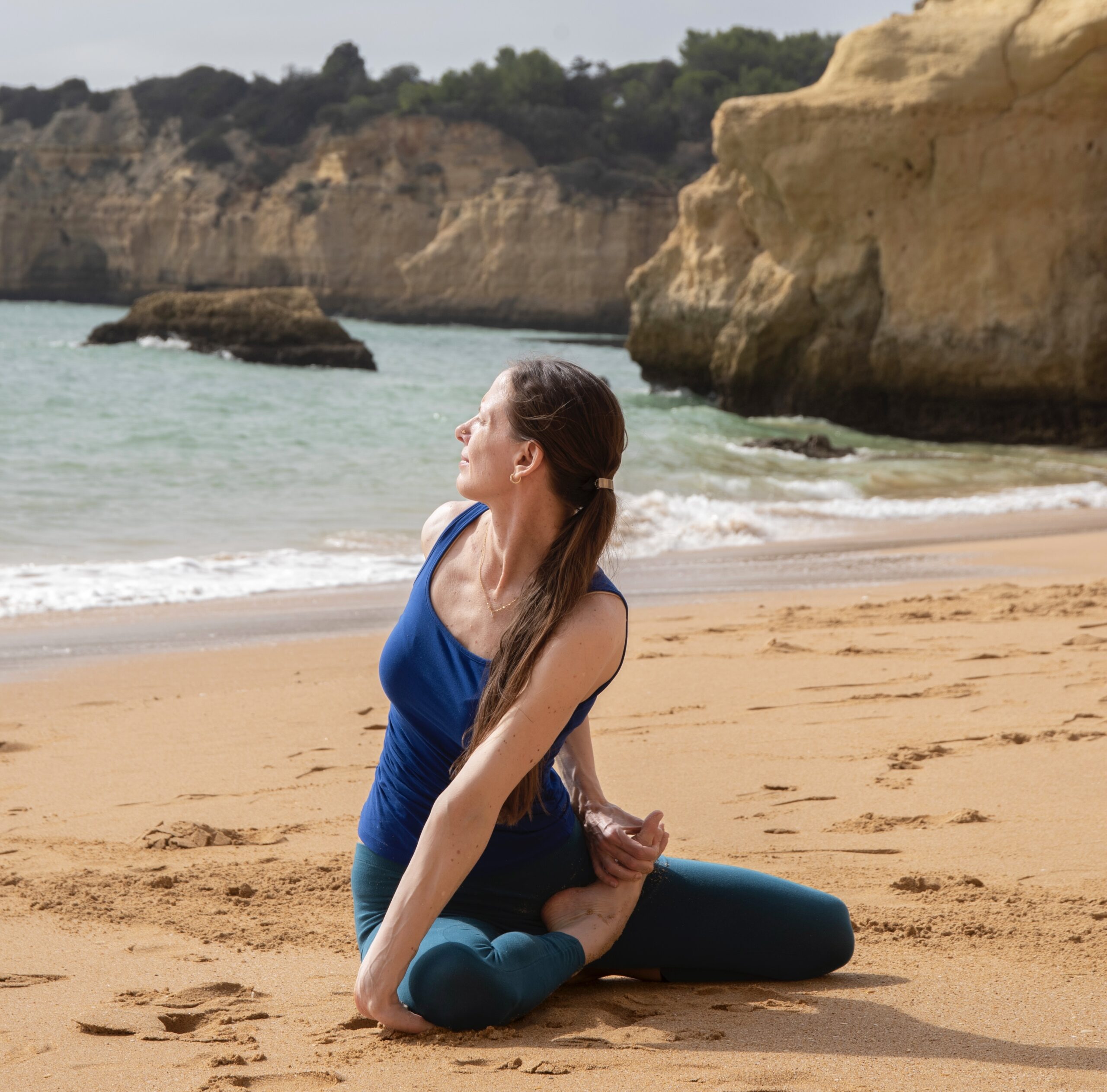
Asanas Purify the Body and Mind
Asana practice is described in two main sacred texts. Patanjali’s Yoga Sutras and the Hatha Yoga Pradipika.
Patanjali has assigned Asana to the third limb of Ashtanga yoga. Following Yama and Niyama, ethics and austerities, Asanas are to be practiced. According to Patanjali’s eight limbs of yoga, Asana practice is followed by Pranayama, breath control, Pratyahara, withdrawal of the sense organs and the internal limbs of Dharana, concentration, Dhyana, meditation and Samadhi, absorption.
There are hundreds of Yoga Asanas. Practitioners of yoga asana begin with Sun Salutations, standing postures, seated postures and then practice progressively deeper yoga postures, including twists, backbends, arm balances and inversions.
According to yoga guru, Sri K Pattabhi Jois, asana is to be practiced five or six days a week, resting on Saturday as well as the new moon and full moon days.
“Sthira Sukham Asanam” – Yoga Sutra 2.46
Yoga postures should be steady and create happiness. Asana should be practiced with a consistent effort, without causing strain or discomfort in the posture, until the asana is mastered.
”Prayatna śaithilya ananta samāpattibhyām” – Yoga Sutra 2.47
By effort and deep relaxation in yoga postures infinite transformations take place. It is important to relax deeply when stretching into yoga postures.
”Tato dvandvanabhighatah” – Yoga Sutra 2.48
According to the Yoga Sutras, when asanas are mastered, one is no longer affected by the pairs of opposites and spiritual realization takes place.
“Practice, practice and all is coming.” – Sri K Pattabhi Jois
Learn new yoga asanas, improve your asana practice and learn to teach asana on Source of Yoga teacher trainings.
Benefits of Ashtanga Yoga Asana Practice
Ashtanga vinyasa yoga includes six series of asanas. The primary series, intermediate series and four advanced series of yoga postures. Each series of yoga postures begins with sun salutations. To create internal heat and awaken the breathing system five sun salutations A and five sun salutations B are practiced.
The primary and intermediate series continue with standing postures, followed by the asanas, which are unique to the series. The advanced series of postures can be practiced directly after the sun salutations. Each series includes about 30 unique yoga postures.
After the postures unique to each series are practiced, urdhva dhanurasana, backbending is practiced.
Each series is completed with the finishing sequence. The finishing sequence includes paschimottanasana(seated forward bend), sarvangasana(shoulderstand), halasana(plough pose), sirsasana(headstand), padmasana(lotus posture) and savasana(corpse pose).
The primary series is known as yoga chikitsa or yoga therapy. The yoga postures of the primary series, improve health, eliminate disease and promote longevity.
The intermediate series is known as nadi shodhana or cleansing of the nadies. The nadies are subtle energy channels, which underlie the physical form. They also relate to the nervous system. Nadi shodhana purifies and strengthens the nervous system and energizes the body.
The advances series are known as sthira bhaga, stabilizing radiance. The advanced series of yoga asanas, continue to purify the body as well as the energy body as well as stabilizing spiritual radiance or exalting good fortune.
Ashtanga Yoga Asanas for Beginners
Ashtanga yoga asanas begin with Surya Namaskara, sun salutations. Traditionally, sun salutations are practiced for one week, prior the adding the practice of standing postures.
The primary series of Ashtanga yoga includes over 70 asanas. Surya Namaskara A consists of 7 important asanas. Surya Namaskara A is practiced five times.
1. Samastitihi – equal standing posture
Samastitihi is practiced by placing the feet together, straightening the legs. Straightening the spine and setting the head at the top of the spine and allowing the crown of the head to feel light. Draw the shoulders back and allow the arms to extend straight down the sides of the body. The opening chant is chanted in Samastitihi, with anjali mudra, prayer position.
2. Ekam – Ekam means one in Sanskrit. Ekam refers to the first position of Surya Namaskara. Inhale, raise the arms above the head, keeping them straight, until the palms of the hands touch. Reach the chin up and look to the thumbs.
3. Uttanasana(standing forward bend) – Dve – Dve means two in Sanskrit. Exhale reach the arms forward and down, fold at the hips and place the hands on the floor next to the feet, keeping the legs straight. Touch the torso to the thighs and the head to the legs, look to the nose.
4. Ardha Uttanasana(half forward bend) Trini – Trini means three in Sanskrit. Inhale, lift the head and raise the torso until the spine is straight. Keep the hands or fingertips in contact with the floor and straighten the arms. Keep the legs straight.
5. Chaturananga Dandasana(four limbed staff posture) – Chatvari – Chatvari means four in Sanskrit. Exhale, hop back into Chaturanga Dandasana, keep the legs straight, bend the arms with the elbows drawn close to the chest, keep the chin raised and look to the nose.
6. Urdhva Mukha Shvanasana(upward facing dog posture) – Pancha(five) – Inhale reach the rib cage forward and up, roll forward over the toes until the toes point straight back, straighten the arms, engage the legs and reach the head back, looking up into the forehead.
7. Adho Mukha Shvanasana(downward facing dog posture) – Shat(six) – Exhale, lift the hips, roll back over the toes, reach the heel down, keeping the left straight. Lower the chest down inline with the hips and hands, draw the chin into the chest and look to the navel. Breathe deeply for five breaths.
At the end of the fifth exhale, hop the feet forward and inhale into Ardha Uttasasana, look into the forehead. Exhale, Uttanasana. Inhale, reach the arms out and up, raise the torso, tilt the head back, touch the palms of the hands together over the head and look to the thumbs. Exhale reach the arms out and down next to the torso, lower the chin and look to the nose in Samastitihi.
Repeat Surya Namaskara A, five times.
